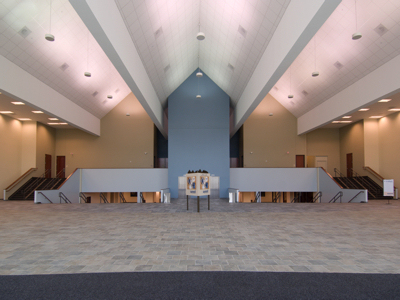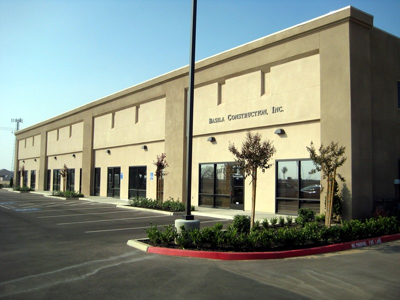Metal Buildings: Sustainable And Adaptable – Part III
By Marge O'Connor, DesignandBuildwithMetal.com
Editor's Note: Metal Buildings: Sustainable And Adaptable is a three-part article based on extensive interviews with industry executives representing leading makers of metal building systems. To read Part I – Relationships And Technology Solidify The Base, click here. To read Part II - Taking It One Step Further, click here.
What Owners And Builders Look For In Metal Buildings
Although metal buildings have been around for more than 50 years, not every potential buyer knows what to look for when evaluating building options. So we asked the experts who work with metal buildings to share their insights on what customers may want
and how manufacturers can meet those needs.
 | |
| | |
 | |
While the ability to economically satisfy large clearspan requirements makes the metal building systems approach a viable option for religious facilities construction, it is the virtually limitless interior and exterior finishing options
that often seals the deal. Shown above and below are examples of contemporary worship centers. In neither case is it readily apparent that metal buildings are at the heart of their construction. The project above is the Summit Christian
Center. It used metal building framing systems and components from Rigid Building Systems.
Shown below is the Weslyan Celebration Centre. It was built with a metal building system and components by Robertson Building Systems.
Click images to enlarge. |  |
 | |
| | |
 | |
Wes Brooker, Marketing Development Manager for American Buildings Company, Eufaula, AL, sees it this way: “We anticipate potential customers will demand much more energy efficient structures utilizing increased insulation, minimal air infiltration,
natural lighting and improved HVAC systems. In some cases our current wall and roof assemblies will have to change to meet these demands so plans are underway to meet all these future needs.”
Buyers who choose metal buildings from manufacturers who primarily market through a national network of local builders will continue to have an advantage over conventional construction methods. “All of us look at how we can solve design issues as
an industry going forward. Conventional construction has to do it on a local level whereas we can look as a national industry. If we look at what’s ahead for energy requirements for buildings, our R+D team can predict worst case scenarios and
determine how we would design those to meet all requirements,” adds Brooker.
Changes will continue as they always have, proving the adaptability of metal buildings and the companies who make them.
“We’re not just rolling out the same product we did ten years ago. The structural designs are flexible and exterior finishing materials provide a variety of textures, profiles, colors and insulation values. This ability to have insulation
and a pre-finished exterior built into the design eliminates other finishing steps at the job site. What remains the same is that when a metal building has served its purpose, it can be recycled into the next metal building,” Roger Burlingame,
President, Ceco Building Systems, Columbus, MS.
Because the buildings can be reconfigured to meet current code requirements and all metal materials can be recycled, the retrofit market remains strong for metal buildings as more building owners recognize these options.
“In an old building you can take off the old roof, just add insulation, or put a whole new roof on top of the existing one. You can add more energy efficiency to the roof while keeping down cost and reducing landfill. It puts new insulation on the
inside and adds a new look or new finish on the outside. We’re doing that more – a new look and new energy efficiency in all kinds of construction,” says Kevin Mickey, Division Sales Manager, Nucor Building Systems, Terrell,
TX.
| |  |  |  |  |  |
| | Bob Zabcik | | Kevin Mickey | | Phil Symes |
The adaptability and durability of metal buildings are long-term factors that more building owners need to evaluate, says Jim Peckham, Manager of Marketing, Varco Pruden Buildings, Memphis, TN. “A pre-engineered building gives the owner tremendous
flexibility to modify the space over the long term. What’s built for one application today can be modified for other applications down the road because space size and roof heights can be reconfigured without difficulty. Plus, buildings that
are 30 or 40 years old are still in use and require very little maintenance because today’s coatings for steel have better solar reflectance and emissivity performance. The paints have also improved their fade or chalk characteristics, so the
roofs deliver long-term energy efficiency and durability.”

| |
The freedom to finish them in virtually any style desired is one of the reasons why metal building systems are now widely used in construction sectors beyond industrial and agricultural. Shown above is the Nason Medical Center, constructed
with a metal building system from Metallic Building Co. Below
is the headquarters of Basila Construction. At the heart of its construction is a metal building system by United Structures of America. Click images to enlarge. |  |
 | |
Bob Zabcik, Director of Research and Development for NCI, on behalf of Metallic Building Company, Houston, TX, suggests that owners think outside the box about how to apply the systems. “We have traditional systems but are not limited to just basics.
There are literally infinite possibilities to the kind of roof and wall assemblies that can be used. It’s also important for them to understand the advantages of steel construction. As an example, many components of metal buildings can be dismantled
and reused when needs or real estate situations change.”
Manufacturers also have adapted their approach to the market, which is an advantage to customers going forward. “We’ve changed the way we go after some projects, especially those that aren’t just metal buildings but are a mixture of
metal buildings and conventional steel construction, such as schools with a gym and classrooms. We’ve added the capabilities to do both types of construction. Another option is to team up with other companies to be part of the project,”
says Zabcik.
These experts say the use of valuable resources on all fronts is important, but the most important first step for buyers is to access the knowledge and experience of the metal building manufacturers and their builders.
| |  |  |  |
| | Roger Burlingame | | Wes Brooker |
Philip M. Symes, Vice President - Sales & Marketing, Star Building Systems, Oklahoma City, OK, puts it this way: “A partnership between a manufacturer and its builders is important for efficient design and delivery of materials and construction.
We provide tools for builders to meet customers’ needs and can help determine the best way to meet specific needs for all areas of the country based on our experience.”
“For a building to be the most cost effective and efficient in design, the designer should consult with manufacturers and builders from the very beginning. It’s the best no-cost move they can make for the end use customer,” says Mickey.
“Involve the manufacturer early in the process, even on something as simple as roof color. Each part has an impact on the building and costs and we can help go through that,” adds Zabcik.
For the metal building manufacturers the market shift toward sustainability is a good thing and their structures will continue to provide great value to owners, occupants and the environment. And they will continue to adapt to the needs of the market
with improved structures and remodeling solutions for existing ones.
Editor's Note: For hotlinks to the websites of the companies mentioned in this article, as well as dozens of other leading manufacturers of metal building systems, please visit the Metal Building Systems and Components section of our Manufacturers & Suppliers Directory here.